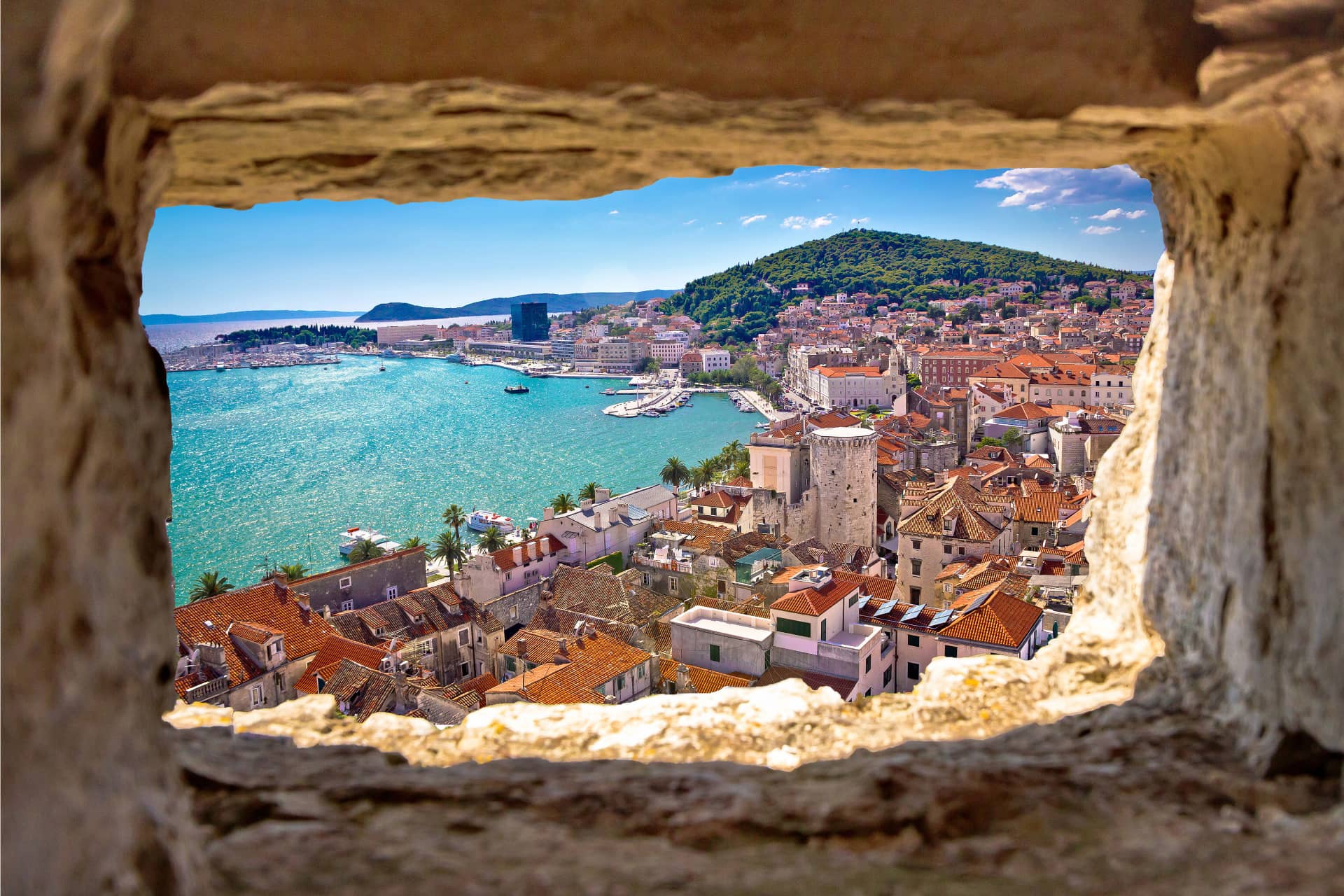There are many sides to this region: a rich history and an abundance of landmarks, exquisite food and wine, endless fun, a pleasant climate year-round, wild mountains and rivers and unspoilt island bays. Large islands, such as Hvar, attract summer crowds and boast exciting nightlife during the summer months. However, if you explore the islands by boat, car or bicycle, you will discover wild secluded beaches, excellent restaurants and wineries in the small villages.
The historic visage of Dalmatia reads like a map of European history from classical antiquity onwards. Salona near Split is the largest Roman settlement on the east coast of the Adriatic Sea and you can find some of the most beautiful Renaissance period sculptures in Croatia in Trogir, a former Greek colony.
You simply must try the local wines, especially those from the islands, as well as Dalmatian prosciutto
The landscape is dominated by limestone, a grey stone slowly dissolved by water and shaped into stunning forms characteristic of karst areas. The mountains of the Dinaric Alps may pose quite a challenge for hikers, for example Biokovo overlooking Makarska, or provide an easy climb to the summits that offer awe-inspiring vistas of the islands of Hvar, Brač and Vis. Still, the swarms of tourists have yet to discover the Split hinterland.
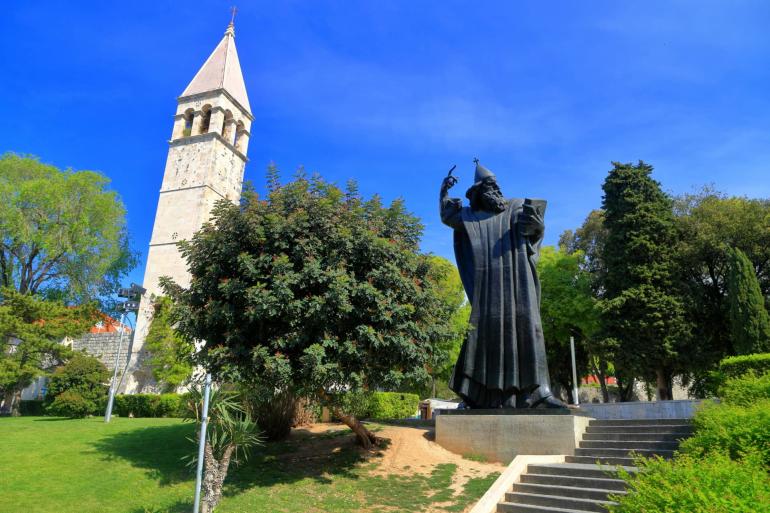 Photo: Inu
Photo: InuStatue of bishop Gregory of Nin holding a book in front of Diocletian's Palace in Split
You simply must try the local wines, especially those from the islands, as well as Dalmatian prosciutto. Local specialities include “pašticada“, an elegant dish of beef doused in sauce and served with gnocchi, or “brodet“, a thick fish stew that goes well with polenta. Another Split specialty is “poljički soparnik“, a geographically protected chard dish baked under embers.
Two millenia old city
Split is the largest city on the Croatian coast, but it grew around the palace of the Roman Emperor Diocletian, which had been built almost two millennia ago. Here you can have your morning cup of coffee in the imperial Peristyle Square, have lunch surrounded by the walls of the erstwhile western gate to the palace and hit the bars in the narrow stone-paved ancient streets at night. The historic centre of Split, built entirely from white stone, is a UNESCO World Heritage site, but the ancient landmarks are a normal backdrop of everyday life in Split – they are not enclosed or set up as an archaeological site.
Regardless of the day of the week, the residents of Split will don their finest attire and take a walk on the Riva and drink together
Split may be a big city, but you are expected to take it easy here. In order to “properly“ enjoy Split, you have to make time to sit on the café terraces, because this is an integral part of social life in the city, as are leasurely strolls along the popular Riva promenade, the palace waterfront. Regardless of the day of the week, the residents of Split will don their finest attire and take a walk on the Riva, say hello to their friends and acquaintances and then probably sit down for a drink. This tranquil experience of watching the world go by in Split and elsewhere in Dalmatia is almost as important as sightseeing.
The best views of Split can be found from the top of the cathedral bell tower and Marjan, a pine-covered hill
Visit Diocletian's mausoleum-turned-cathedral, as well as the palace basement halls, and locate the narrowest street in Split dubbed “Pusti me proć'“ (Let me pass) next to the Temple of Jupiter, which has been transformed into a church. Visit the local market and try some homegrown fruit and vegetables - good indicators of ‘homegrown’ are varied sizes and an occasional blemish - or go to the fish market and test your fish identification skills. In line with the long history, the museums are true treasure troves and if you happen to be in Split during the summer festival, you should catch a performance of Giuseppe Verdi's Aida at the Peristyle.
The best views of Split can be found from the top of the cathedral bell tower and Marjan, a pine-covered hill and a favourite picnic spot of the residents of Split, a 30-minute walk away from the Riva.
 Photo: Daniel Jedzura
Photo: Daniel JedzuraWine connoisseurs should definitely explore mainland Hvar, either by bike or by car, because some of the best Croatian winemakers have their wineries here
At the Bačvice city beach, you can play or observe “picigin“, a “sport“ that was invented here and has one simple rule: pass a tiny ball around by slapping it with an open palm whilst running and jumping a lot in ankle deep water. While hardly a formally regulated sport, “picigin“ does have an avid fan base. If you prefer regular sports, you can buy the scarf of Torcida, the first soccer fan club in Europe. The Torcida are supporters of Hajduk, one of the oldest football clubs in Continental Europe.
If you get bored with the city, the surrounding area provides enough activities to last you a month.
People in Split believe that touching the big toe of the statue of bishop Gregory of Nin will make your wish come true
And finally, just outside the northern Golden Gate of Diocletian's Palace, you will see a large statue of a prominent Croatian bishop, sculpted by the equally prominent Croatian sculptor Ivan Meštrović. The importance of this statue lies in the belief that touching its big toe will make your wish come true. We don't have any data on the success rate of the wishing toe, but touching it is a must!
Hvar - history of seafarers, merchants and the occasional pirate
Hvar, a former ancient Greek colony, is an island of vibrant nightlife, gorgeous beaches, lavender, exquisite wines and restaurants. The town of Hvar is a trendy summer resort and the nearby Paklinski archipelago is a must-visit due to its secluded beaches, unique restaurants and unforgettable bars. The warm and sunny climate means that you can also enjoy yourselves on Hvar during spring and autumn and avoid the large summer crowds.
Wine connoisseurs should definitely explore mainland Hvar, either by bike or by car, because some of the best Croatian winemakers have their wineries here.
The town of Stari Grad (‘Old Town’) is the oldest settlement on the island. Almost 2,500 years ago, the inhabitants of the Greek island of Pharos formed a colony here and divided the fertile land in the vicinity into neat parcels. This unique example of a preserved hora or a Greek field is one of the UNESCO World Heritage sites.
The town of Stari Grad is the oldest settlement on the Hvar island. It was founded by Greek settlers almost 2,500 years ago
Hvar's safe ports made the island a regular stop for seafarers, merchants and the occasional pirate. The wealth of the island is best shown by its historic buildings and the theatre in the town of Hvar holds a record: it is the oldest continuously operating theatre in Europe that was open to all classes of society. It was opened in 1612, when Shakespeare was still diligently working on his plays in England.
Brač island, home of the Golden Cape
“Zlatni rat“ (Golden Cape), a long pebble spit near the town of Bol, on the island of Brač, is one of the most popular beaches on the Adriatic coast. Brač, which is less than an hour away from Split by ferry, hides charming fishing villages in its deep bays. The most famous local product is Brač stone, a white marble-like type of limestone that has been the most frequently used building material in Dalmatia ever since the Roman period. Stonecutters from Brač still make various practical objects and decorations using stone extracted from the local quarries.
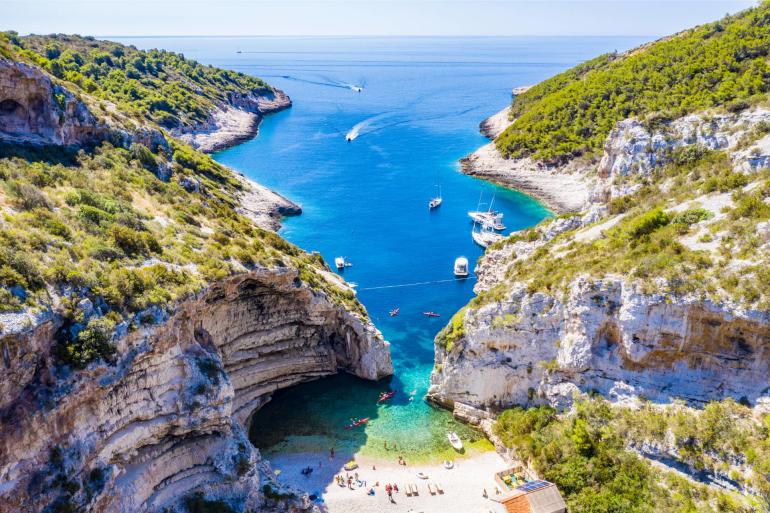 Photo: Mislaw
Photo: MislawStiniva beach is one of the most beautiful in Europe. It is never really crowded since it is only accessible by a taxi boat from the nearby village or by taking a long walk and descending a steep slope
The menus in Brač are typically Dalmatian: wine, olive oil, rosemary, fish… Hikers will be interested in the excursion to Mount Vid and the mystical Dragon's Cave beneath the summit, while a glimpse into history is provided by a visit to the Roman quarries and the living quarters of the hermit monks in the Blaca “desert“ - a barren karst plateau in the centre of the island, which is awaiting UNESCO World Heritage status.
Vis and Biševo islands
The most beautiful location on Vis, the farthest inhabited island in the Adriatic, is Stiniva bay with its small pebble beach enclosed by tall cliffs that form a narrow passage towards the open sea only a few metres wide. Stiniva beach is hardly crowded: it is only accessible by a taxi boat from the nearby village or by taking a long walk and descending a steep slope. However, the trip will definitely be worth your while, if only to brag about visiting the beach that was voted the most beautiful in Europe, in a poll conducted by the Brussels organisation European Best Destinations.
If you decide to spend your holiday on Biševo, you won't have to fight the other tourists for a good spot on the island's stunning beaches
Visiting Modra špilja (the Blue cave) on the nearby island of Biševo is another unforgettable experience. This is a semi-submerged cave and the light only penetrates through an underwater opening around noon during fine weather. The sun reflects off the white pebble bottom and gives the cave a bluish hue and objects in the water a silver tint.
According to the latest census, Biševo has only 15 permanent residents, but the number of people increases during the summer months. If you decide to spend your holiday on Biševo, you won't have to fight the other tourists for a good spot on the island's stunning beaches, but don't expect any particularly exciting nightlife.
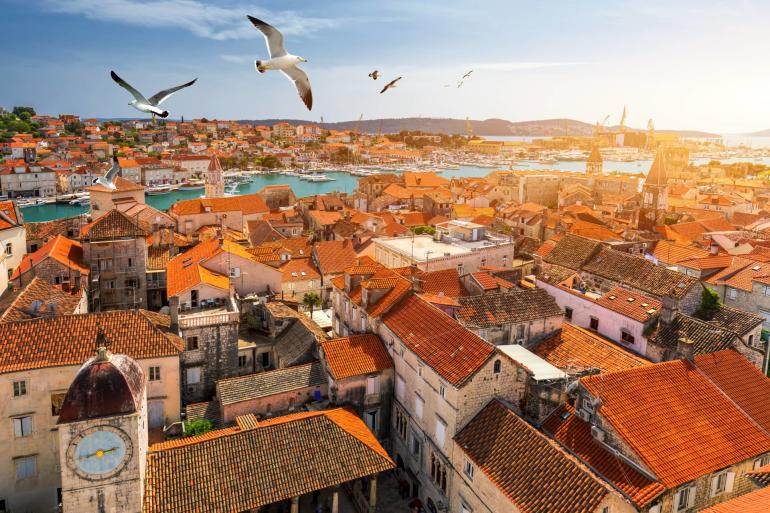 Photo: DaLiu
Photo: DaLiuTrogir is a town that doubles as a museum: the centre is a UNESCO World Heritage site, owing to its historic landmarks, especially the Cathedral of St. John, a Renaissance masterpiece
The nightlife on Vis is somewhat more eventful, especially in Vis and Komiža, which are the two biggest towns on the island. Once there, visiting the former military facilities is also highly recommended. In the former Yugoslavia, Vis was closed to foreigners as it was one of Marshal Tito's safe havens. One of the most unusual experiences on Vis is the tour of “Tito's Cave“, where the Marshal used to spend his days during the closing stages of WWII.
Trogir, busy tourist centre
In a narrow strait between the mainland and Čiovo Island, on a small islet barely a couple of hundred meters wide, lies Trogir. Considering its excellent location with a naturally formed moat, it should come as no surprise that Trogir was founded as a Greek trading post. Trogir is a town that doubles as a museum: the centre is a UNESCO World Heritage site, owing to its historic landmarks, especially the Cathedral of St. John, a Renaissance masterpiece.
The Split hinterland has some interesting sites, such as the town of Sinj, famous for the “alka“ - a chivalric tournament
Bridges connect the present-day Trogir both with the mainland and the island of Čiovo, where many residents of Split have their summer houses, making Trogir one of the busiest tourist centres in the surrounding area during the summer months.
The nearby islands of Drvenik Veli, Drvenik Mali and Šolta are easily accessible from Trogir and the beaches there aren't as crowded.
Zagora – Split hinterland
Mass tourism still eludes Zagora (literally “behind the hills“), the area behind the Dalmatian mountains. The Split hinterland has some interesting sites, such as the town of Sinj, famous for the “alka“, a chivalric tournament that has been continuously held here for the last three hundred years, and Our Lady of Sinj, which attracts a large number of pilgrims. Vranjača is an intriguing cave located in Dugopolje, and the Cetina River is perfect for canyoning and rafting. The mountains provide a venue for easy hiking tours or challenging full-day climbs.
 Photo: Brch
Photo: BrchOmiš is situated at the foot of a steep stone cliff guarded by sturdy fortresses at the mouth of the Cetina River
En route from Split to the mainland, make sure you stop at the Klis Fortress, which was built on a tall cliff that offers a beautiful view of the islands and the surrounding area. Other bigger towns in Zagora, such as Sinj, Vrgorac and Imotski, also have forts of their own.
Near the old trading town of Imotski are two examples of karst phenomena, the Red (Crveno) and Blue (Modro) Lakes
Vrgorac is situated on a fertile plateau, where the best strawberries in the entire region are grown. The surrounding area of Vrgorac has an interesting rural tourism offer, and the landmarks include burial mounds of prehistoric Illyrian tribes and “stećci“, unusual medieval standing tombstones scattered throughout the region.
Near the old trading town of Imotski are two examples of karst phenomena, the Red (Crveno) and Blue (Modro) Lakes, which are essentially two deep holes in a stone plateau. The Blue Lake is larger and you can take a dip there in the summer. The Red Lake is a depression – its bed is located below sea level and in places its depth surpasses 300 m.
Split’s surrounding area
While you're sitting in the small town square of Omiš, next to the Church of St. Michael, you will notice a very steep stone cliff protruding from behind the houses and looming over the town. Beside you is the “House of a happy man“, whose identity remains unknown, but we do know that he was happy because in the 15th century house an inscription above the entrance reads: „I thank thee, Lord, for letting me live in this world“. Omiš is a town of “klapas“, Dalmatian polyphonic a capella vocal groups, and long sandy beaches. It is also a departure point for rafting tours on the Cetina River. However, a long time ago it used to be a pirate's nest.
Omiš is situated at the foot of a steep stone cliff guarded by sturdy fortresses at the mouth of the Cetina River, which carved a deep canyon in this very place. The Omiš pirates built a transverse wall in the river, which their shallow-drafted ships were able to cross, unlike those of their pursuers. Real pirates are long gone, although they do come to life every summer at the amusing “pirate“ festivals, much to the joy of locals and tourists.
The Cetina River canyon is extremely photogenic, regardless of whether you are observing it from a boat, the fortress on the cliff overlooking Omiš, or Mount Gradac, an important site in the history of the former Duchy of Poljica, a small rural republic surrounding the slopes of Mount Mosor. The Cetina River is the perfect for rafting: it provides some exciting rides, especially after the heavy spring rains, and in the summer it is suitable for the entire family.
Omiš is situated at the foot of a steep stone cliff guarded by sturdy fortresses at the mouth of the Cetina River, which carved a deep canyon in this very place
The Makarska Riviera extends further down south with a series of small tourist towns and villages with gorgeous pebble beaches. Here you will also find one of the most photographed spots on the Adriatic coast: a large rock with a small pine tree lying in the shallow sea by the pebble beach in the village of Brela.
The Salona Archaeological Park is just outside of Split. Salona was the largest Roman settlement on the east Adriatic coast with a population of 60,000. Particularly captivating is the amphitheatre that could seat 18,000 people and you should also pay attention to Salona's main gate, where there are 5 cm deep ruts carved into the stone. Just imagine the sheer number of waggons that must have passed to make incisions this deep in the stone!
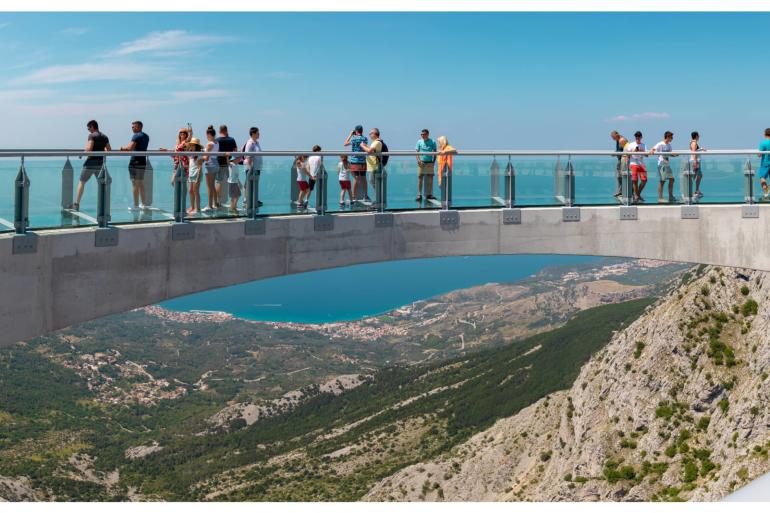 Photo: Antonio Batinic
Photo: Antonio BatinicSkywalk Biokovo is a horseshoe-shaped platform out off the cliff with a glass walkway. It is located in the southwestern part of the Biokovo Nature Park
When heading to the hinterland, make sure you stop at the Klis Fortress, a seat of Croatian kings. On your way to Trogir, you will pass the seven Kaštels, small towns established around the seven small castles or residential forts.
Biokovo and other mountains in the Split area
Rising above Makarska, one of Dalmatia’s tourist centres, is the steep rock face of Biokovo. You will feel lightheaded just thinking about climbing this limestone wall. The cliff seems impassable and you can hardly imagine that there is a path that will lead you up to the second highest peak in Croatia. But once you embark on your hike, a winding path carved into the rock slowly rises and the magnificent view of the sea and the Dalmatian islands becomes wider with each step. You will be hard pressed to find such a challenging mountain this close to the sea anywhere else in the world!
Although there are no peaks higher than 2000 m in Croatia, that doesn't make them any less demanding for climbing and hiking
Biokovo is a part of the Dinaric Alps, a limestone mountain range extending along the Adriatic Sea. Water slowly dissolves the limestone and forms karst, a broken rocky landscape teeming with cracks, caves and sinkholes. This magnificent rocky terrain makes the Dinaric Alps exceptionally challenging for hikers. Although there are no peaks higher than 2000 m in Croatia, that doesn't make them any less demanding. As evidenced by Biokovo, the climb can begin at sea level and the terrain is quite taxing. Climbing St. George (Sv. Jura), the highest peak of Biokovo, takes five hours for hikers that are in great shape, but you should also bear in mind that you usually need to return on the same day because there aren't that many mountain cabins in the Dinarides area.
Biokovo Nature Park
The Biokovo Nature Park is accessible to everyone because a road leads to the summit and there are also a number of shorter and less demanding paths that lead to other fascinating locations in the park. The best way to enjoy it is by visiting the Skywalk Biokovo - a horseshoe-shaped platform out off the cliff with a glass walkway. It is located in the southwestern part of the Biokovo Nature Park.
The hiking trails in Croatia are clearly indicated by hiking markings (a red circle with a white centre), while the better-stocked bookstores offer hiking maps and you can also get detailed GPS maps.
While taking a break from hiking, you should definitely try canyoning, rafting on the Cetina River
Ranges Kozjak and Omiš Dinara also provide interesting climbs of medium difficulty coupled with an excellent view of the sea. Perun, a low littoral hill between Split and Omiš, provides easy paths that connect an array of small medieval churches on the summits with traditional hamlets at the bases. Mount Vid on the island of Brač is a particular treat.
Mosor's hiking trails are more challenging, especially a transversal path along the ridge of this mountain in the vicinity of Split.
Several rock climbing areas have been set up in the area around Split: the Cetina River canyon near Omiš, the south cliffs of Mount Marjan in Split and Kozjak overlooking Kaštela Bay. While taking a break from hiking, you should definitely try canyoning, rafting on the Cetina River or visit the Vranjača cave near Dugopolje.
